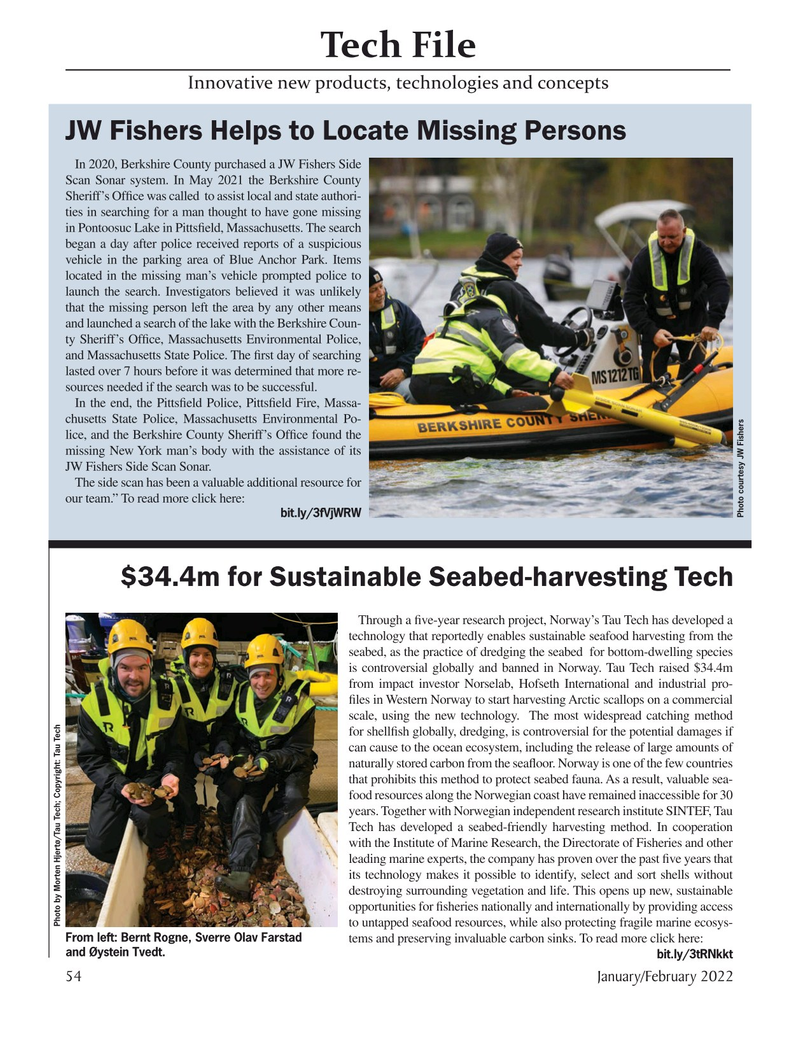
Page 54: of Marine Technology Magazine (January 2022)
Read this page in Pdf, Flash or Html5 edition of January 2022 Marine Technology Magazine
Tech File
Innovative new products, technologies and concepts
JW Fishers Helps to Locate Missing Persons
In 2020, Berkshire County purchased a JW Fishers Side
Scan Sonar system. In May 2021 the Berkshire County
Sheriff’s Of? ce was called to assist local and state authori- ties in searching for a man thought to have gone missing in Pontoosuc Lake in Pitts? eld, Massachusetts. The search began a day after police received reports of a suspicious vehicle in the parking area of Blue Anchor Park. Items located in the missing man’s vehicle prompted police to launch the search. Investigators believed it was unlikely that the missing person left the area by any other means and launched a search of the lake with the Berkshire Coun- ty Sheriff’s Of? ce, Massachusetts Environmental Police, and Massachusetts State Police. The ? rst day of searching lasted over 7 hours before it was determined that more re- sources needed if the search was to be successful.
In the end, the Pitts? eld Police, Pitts? eld Fire, Massa- chusetts State Police, Massachusetts Environmental Po- lice, and the Berkshire County Sheriff’s Of? ce found the missing New York man’s body with the assistance of its
JW Fishers Side Scan Sonar.
The side scan has been a valuable additional resource for our team.” To read more click here: bit.ly/3fVjWRW
Photo courtesy JW Fishers $34.4m for Sustainable Seabed-harvesting Tech
Through a ? ve-year research project, Norway’s Tau Tech has developed a technology that reportedly enables sustainable seafood harvesting from the seabed, as the practice of dredging the seabed for bottom-dwelling species is controversial globally and banned in Norway. Tau Tech raised $34.4m from impact investor Norselab, Hofseth International and industrial pro- ? les in Western Norway to start harvesting Arctic scallops on a commercial scale, using the new technology. The most widespread catching method for shell? sh globally, dredging, is controversial for the potential damages if can cause to the ocean ecosystem, including the release of large amounts of naturally stored carbon from the sea? oor. Norway is one of the few countries that prohibits this method to protect seabed fauna. As a result, valuable sea- food resources along the Norwegian coast have remained inaccessible for 30 years. Together with Norwegian independent research institute SINTEF, Tau
Tech has developed a seabed-friendly harvesting method. In cooperation with the Institute of Marine Research, the Directorate of Fisheries and other leading marine experts, the company has proven over the past ? ve years that its technology makes it possible to identify, select and sort shells without destroying surrounding vegetation and life. This opens up new, sustainable opportunities for ? sheries nationally and internationally by providing access
Photo by Morten Hjertø/Tau Tech; Copyright: Tau Tech to untapped seafood resources, while also protecting fragile marine ecosys-
From left: Bernt Rogne, Sverre Olav Farstad tems and preserving invaluable carbon sinks. To read more click here: and Øystein Tvedt.
bit.ly/3tRNkkt 54 January/February 2022
MTR #1 (50-63).indd 54 1/25/2022 8:51:22 AM

 53
53

 55
55
